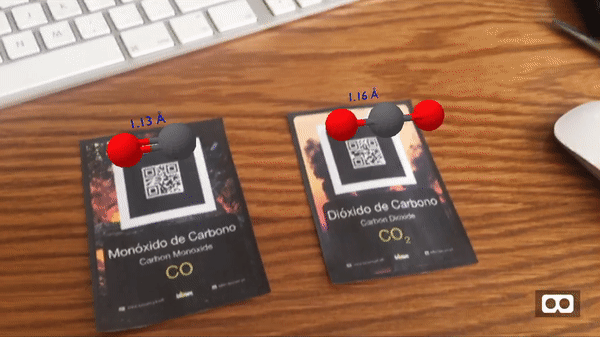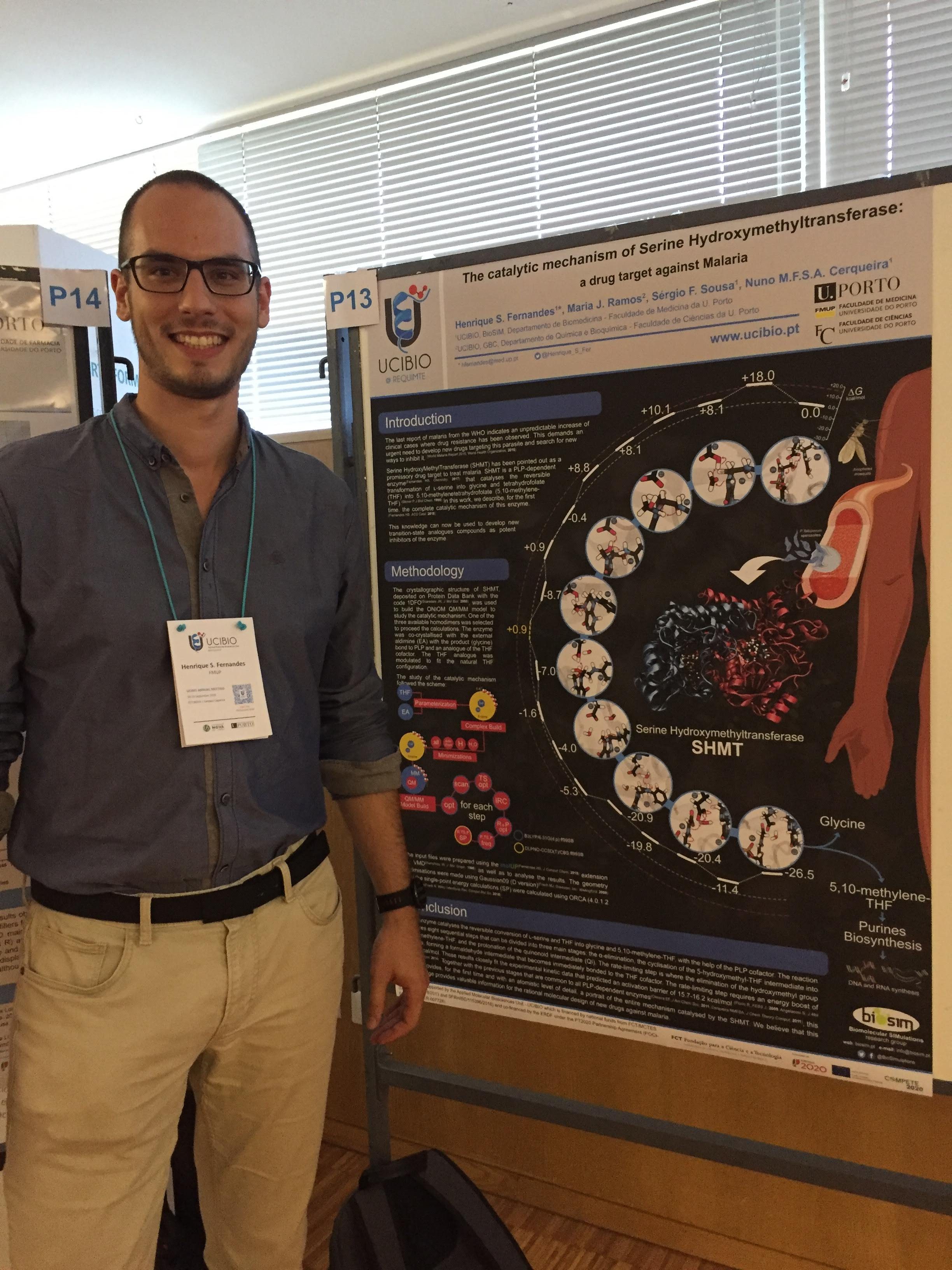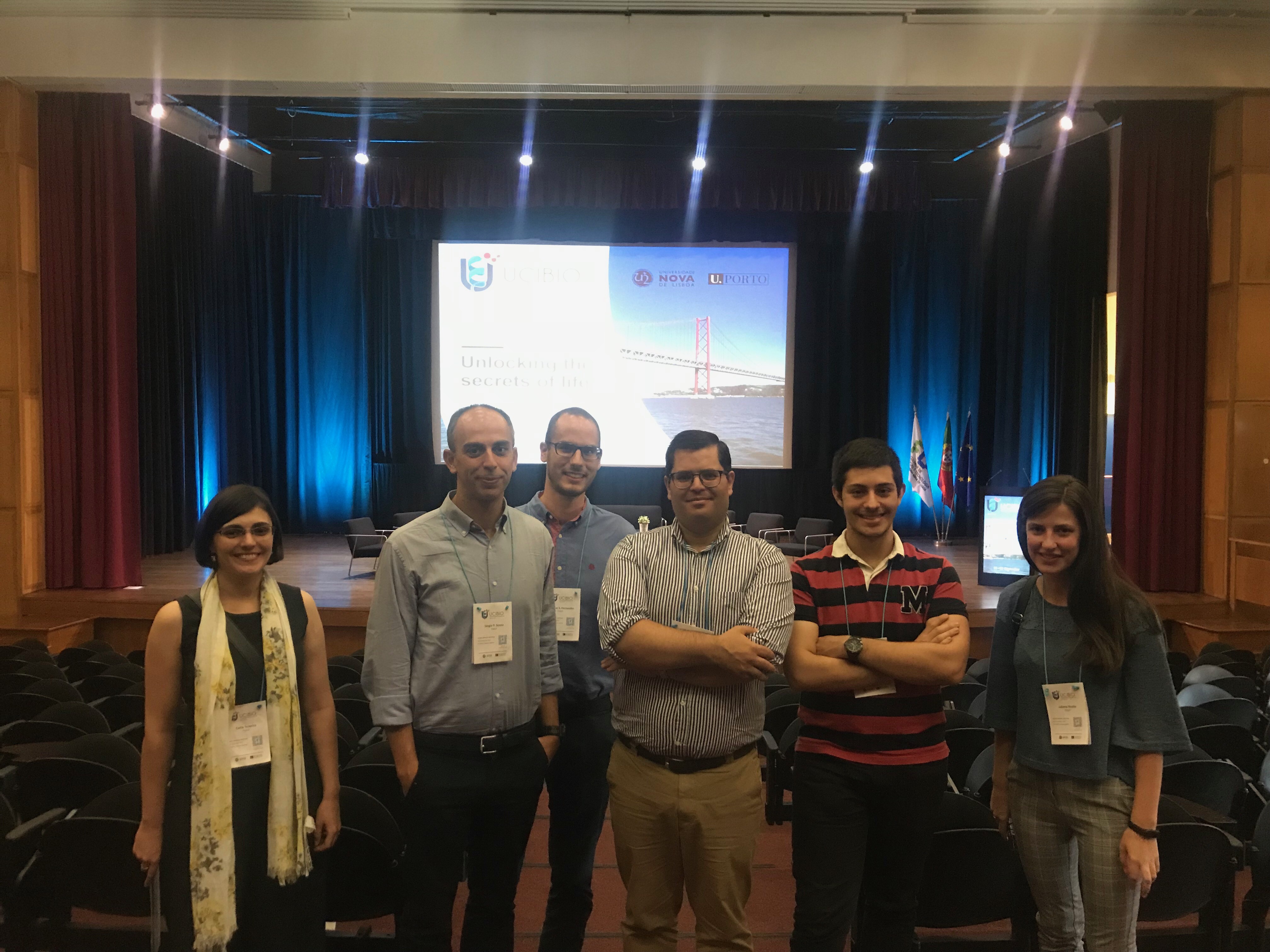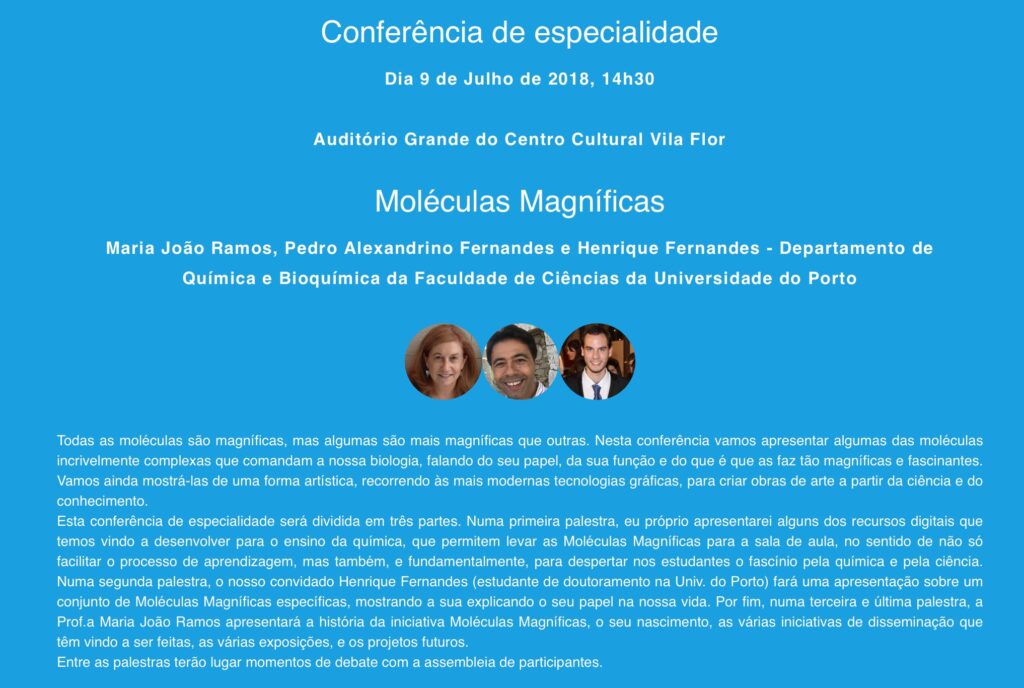I was at the 19th YSF and 44th FEBS conferences, in Krakow – Poland, during the last week (July 3rd to 11th) presenting my work about “Enhancing the catalytic power of Serine Hydroxymethyltransferase to produce commercially valuable compounds”. It was an excellent congress where I got some new ideas for the future. Thank you
VII AEICBAS Biomedical Congress
I would like to thank the Organising Committee of the VII AEICBAS Biomedical Congress (2019, March 17th) for the invitation to share my experience as a biochemist.


Poster at EJIBCE 2018
Is the 5,10methylenetetrahydrofolate cofactor synthesized through a non-enzymatic or enzymatic mechanism?
Fernandes, H. S., Sousa, S. F., and Cerqueira, N. M. F. S. A.

Desenvolvimento de Software com Aplicação no Ensino Em Química e Biologia – VII Encontro da Divisão de Ensino e Divulgação da Química
Last Saturday (November 17th), I was presenting some of the software that we have developed at BioSIM research group to improve the way some chemical concepts are taught to our students.
VMD extensions, such as VMD Magazine, ToolBar, Protein Wars, and VMD Store were presented during the “VII Encontro da Divisão de Ensino e Divulgação da Química” conference. During the presentation, the software features were presented and were showed how these extensions can be used to engage young students to learn chemistry in a more pleasant and clear manner.
Moreover, the BioSIM Augmented Reality technology was presented for the first time, and it allows an easy and costless way to see molecules using augmented reality. See the video below:
Poster at UCIBIO Annual Meeting 2018 – Lisbon
On September 28-29, I was presenting my recently published work at the UCIBIO Annual Meeting in Lisbon (FCT-NOVA).
The catalytic mechanism of Serine Hydroxymethyltransferase: a drug target against Malaria
Henrique S. Fernandes, M. J. Ramos, Sérgio F. Sousa, and N. M. F. S. A. Cerqueira
Moléculas Magníficas – V Encontro Internacional da Casa das Ciências 2018
Conferência de especialidade
Dia 9 de Julho de 2018, 14h30
Auditório Grande do Centro Cultural Vila Flor
Moléculas Magníficas
Maria João Ramos, Pedro Alexandrino Fernandes e Henrique Fernandes – Departamento de Química e Bioquímica da Faculdade de Ciências da Universidade do Porto
Esta conferência de especialidade será dividida em três partes. Numa primeira palestra, eu próprio apresentarei alguns dos recursos digitais que temos vindo a desenvolver para o ensino da química, que permitem levar as Moléculas Magníficas para a sala de aula, no sentido de não só facilitar o processo de aprendizagem, mas também, e fundamentalmente, para despertar nos estudantes o fascínio pela química e pela ciência. Numa segunda palestra, o nosso convidado Henrique Fernandes (estudante de doutoramento na Univ. do Porto) fará uma apresentação sobre um conjunto de Moléculas Magníficas específicas, mostrando a sua explicando o seu papel na nossa vida. Por fim, numa terceira e última palestra, a Prof.a Maria João Ramos apresentará a história da iniciativa Moléculas Magníficas, o seu nascimento, as várias iniciativas de disseminação que têm vindo a ser feitas, as várias exposições, e os projetos futuros.
Entre as palestras terão lugar momentos de debate com a assembleia de participantes.
Poster | 5º Encontro Português de Jovens Químicos (PYCheM) and 1st European Young Chemists Meeting
Centro Cultural Vila Flor, Guimarães
2016, 22th to 24th April
Poster: “Computational studies addressed to the catalytic mechanism of Histidine Decarboxylase”
Henrique S. Fernandes (1), Maria João Ramos, Nuno M. F. S. A. Cerqueira (1)
(1) UCIBIO/REQUIMTE, Departamento de Química e Bioquímica, Faculdade de Ciências, Universidade do Porto, Rua do Campo Alegre s/n, 4169-007 Porto, PT
Mammalian histidine decarboxylase (mHDC) is an enzyme that requires pyridoxal-5′-phosphate (PLP) as a cofactor [1-3]. mHDC belongs to the group II of PLP-dependent decarboxylases together with L-DOPA and glutamate decarboxylases, and catalyses the L-histidine decarboxylation from which results histamine.
Histamine plays a key role in several biological events such as immune response, gastric system modulation and as a neurotransmitter in the nervous system. Several inhibitors for histamine action have been studied in order to treat some diseases such as atopic dermatitis, allergies, and cancer.
mHDC has been studied for a long time, but only in 2012 Komori’s [2] group was able to determine the X-ray structure of the enzyme and revealed the active site environment. Till date, only hypothesis about the catalytic mechanism of mHDC were available and based on homology models (that propose a different active site configuration).
In this work, we studied the catalytic mechanism of mHDC by computational approaches using the recent X-ray structure of mHDC (PDB code: 4E1O [4]) and a QM/MM methodology.
The results have shown that mHDC catalyses the reaction in a two-step type of mechanism. The first step involves a decarboxylation that is followed by the formation of a stable carbanion. In the second step, the carbanion is protonated by a base from which results histamine.
[1] Ngo, H. P., Cerqueira, N. M., Kim, J. K., Hong, M. K., Fernandes, P. A., Ramos, M. J., and Kang, L. W., Acta crystallographica. Section D, Biological crystallography 2014, 70, 596-606
[2] Oliveira, Eduardo F.; Cerqueira, Nuno M. F. S. A.; Fernandes, Pedro A. and Ramos, M.J., Journal of the American Chemical Society 2011, 133, 15496-15505
[3] Cerqueira, N. M. F. S. A.; Fernandes, P. A.; Ramos, M. J., Journal of Chemical Theory and Computation 2011, 7, 1356-1368
[4] Komori, H., Nitta, Y., Ueno, H., and Higuchi, Y., Acta Crystallogr Sect F Struct Biol Cryst Commun 2012, 68, 675-677
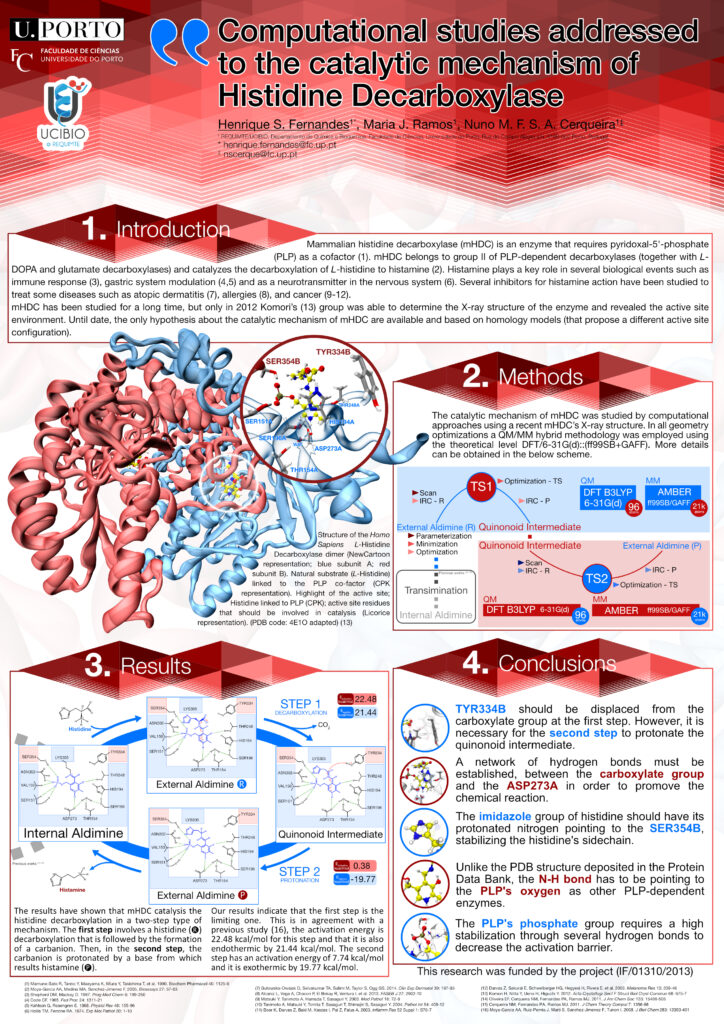
Poster | Encontro de Jovens Investigadores em Biologia Computacional Estrutural
Instituto Pedro Nunes, Coimbra
2015, 18th December
Poster: “Computational studies addressed to the catalytic mechanism of Histidine Decarboxylase”
Henrique S. Fernandes (1), Nuno M. F. S. A. Cerqueira (1)
(1) UCIBIO/REQUIMTE, Departamento de Química e Bioquímica, Faculdade de Ciências, Universidade do Porto, Rua do Campo Alegre s/n, 4169-007 Porto, PT
Mammalian histidine decarboxylase (mHDC) is an enzyme that requires pyridoxal-5′-phosphate (PLP) as a cofactor [1]. mHDC belongs to the group II of PLP-dependent decarboxylases together with L-DOPA and glutamate decarboxylases, and catalyses the L-histidine decarboxylation from which results histamine.
Histamine plays a key role in several biological events such as immune response, gastric system modulation and as a neurotransmitter in the nervous system. Several inhibitors for histamine action have been studied in order to treat some diseases such as atopic dermatitis, allergies, and cancer.
mHDC has been studied for a long time, but only in 2012 Komori’s [2] group was able to determine X-ray structure of the enzyme and revealed the active site environment. Until date, only hypothesis about the mechanism of mHDC were available and based on homology models (that propose a different active site configuration).
In this work we are studying the catalytic mechanism of mHDC by computational means using the recent X-ray structure of mHDC and a QM/MM methodology.
The results have shown that mHDC catalyses the reaction in a two-step type of mechanism. The first step involves a decarboxylation that is followed by the formation of a carbanion. In the second step, the carbanion is protonated by a base from which results histamine. Our early results indicate that the first step is the limiting reaction step and the full reaction is endothermic by approximately 25 kcal/mol.
[1] Ngo HP, Cerqueira NMFSA, Kim JK, Hong MK, Fernandes PA, et al. 2014. Acta Crystallogr D Biol Crystallogr 70: 596-606;
[2] Komori H, Nitta Y, Ueno H, Higuchi Y. 2012. Acta Crystallogr Sect F Struct Biol Cryst Commun 68: 675-7
